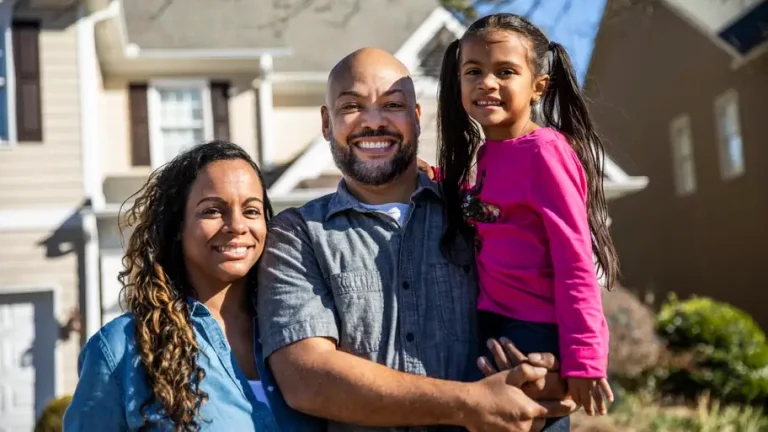In an effort to address the stubbornly persistent racial wealth gap, one of the nation’s largest banks has launched a mortgage program aimed at first-time homebuyers in Black and Latino neighborhoods. The program’s loose qualifying standards remove some of the major barriers to homeownership — but they also could create a risk of default for borrowers with little safety net.
New no-down payment mortgage
Bank of America’s new Community Affordable Loan Solution requires no down payment requirement, no closing costs, no minimum credit score and no mortgage insurance. The program for now is limited to first-time buyers in African-American or Black and Hispanic-Latino neighborhoods in Charlotte, Dallas, Detroit, Los Angeles and Miami. A key distinction: In addition to the first-time buyer requirement, the bank will determine eligibility for the program by the borrower’s location and income, not race.
An official from a prominent organization of Black real estate brokers lauded the bank’s initiative.
“It’s going to take more than one institution to make a dent, but any positive step toward addressing what has been an ongoing issue is a step in the right direction,” says Danny Felton, a real estate broker in Miami and second vice president of the National Association of Real Estate Brokers.
In one generous feature of Bank of America’s program, borrowers aren’t subject to mortgage insurance premiums. Most low-down payment conventional loans, as well as the 3.5 percent-down FHA loan, carry mortgage insurance. Felton describes that conundrum as “the poor pay more.”
An unequal housing economy
Bank of America’s program aims to address an ongoing challenge for the U.S. housing market: Black and Hispanic Americans’ struggle to attain homeownership. While nearly three-quarters of White Americans owned their homes as of the second quarter of 2022, less than half of Black and Hispanic Americans were homeowners, according to the U.S. Census Bureau.
There are many reasons for the racial homeownership gap, including lower incomes and less household wealth among Black and Hispanic Americans, along with the real estate industry’s history of discriminatory lending practices. Mortgage lenders long ago abandoned such overtly biased practices as redlining, but the economic wounds have been slow to heal. A growing body of research suggests that homes owned by African Americans today are undervalued by appraisers, and in one recent survey, close to half of Black and Hispanic homebuyers reported missing out on homes in certain neighborhoods due to discrimination.
Borrower beware
Bank of America’s program is attractive for the borrowers who qualify. However, it also comes with something of a red flag: Compared to borrowers who clear stringent qualifying hurdles, borrowers who buy a home with no down payment, no closing costs and no minimum credit score face a much higher risk of default. To soften that risk, the bank is requiring borrowers in the program to complete a homebuyer certification course.
Even so, these new owners will buy at what might be the top of the housing market, and with no equity to cushion them against a decline in prices.
“As well-intentioned as the program may be, introducing a no-down payment program for first-time homebuyers after a major run-up in home prices could be setting up some homebuyers for failure if home prices pull back or even level out for a period of time,” says Greg McBride, Bankrate’s chief financial analyst. “Without meaningful home price appreciation, the loan balance doesn’t decline fast enough to build a sufficient equity cushion if the homeowner needs to sell within a few years.”
For most Americans, homeownership is a crucial means to wealth-building. A mortgage default or foreclosure can be devastating to that effort.
In other words, buying now is a balancing act, especially for those on the financial margins.
Felton says the bank’s homebuyer course requirement is an important safeguard, however — and while it won’t impose a minimum credit score to qualify, the bank will also check borrowers’ credit and payment histories, such as for car insurance, rent and utilities.
“It’s not a no-credit program,” says Felton. “You have to have three tradelines for at least 12 months, which is a credit history.”
Tips for eligible borrowers
For homebuyers who qualify, Bank of America’s initiative offers a compelling deal. While a number of loan programs accommodate buyers with low to no down payments, all come with higher fees for things such as mortgage insurance.
- Make sure you’re ready. Before becoming a homeowner, take a hard look at your finances. Make sure you can afford your mortgage in addition to any student loans, car payments or other debt. Also consider the stability of your income.
- Build up your savings. Homeownership is generally a sound financial move, but it’s expensive. In addition to property taxes and homeowners insurance, you’re also on the hook for maintenance, repairs, pest control, landscaping and other ongoing costs.
- Look into grant programs. Most states and some cities and nonprofits offer down payment assistance for first-time homebuyers. Even if you’re not buying in a neighborhood covered by Bank of America’s new initiative, homebuyer assistance programs are available nationwide.
- Consider house-hacking. A new name for an old strategy, house-hacking means living in a duplex or triplex. You occupy one unit and then rent the other out, and your tenants help pay the mortgage.
